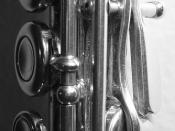Music is the universal language of culture. The emotion evoked from a piece of music inspires people all over the world. Music is constantly changing with society's views of popularity and need for betterment. For generations, music was a concept of solely vocal chants, melodies, organums, and little or no notations. Then instruments such as the rebec, pipe, and psaltery were among the first used. Instrumental music, also known as estampie, was invaluable and mainly for entertainment and dance. It wasn't until the end of the seventeenth century that instrumental music surpassed vocal music on levels of importance and acceptance. Composers, with new ideas and visions, took the reigns in the world of music. Instruments became the main tools of musicians and composers. There arose six broad categories of instruments that western musicians today classify as the string, woodwind, brass, percussion, keyboard and electronic. Each category incorporates a range of instruments that have created living history through music.
Each instrument brings its own tone color to the music and has a variety of other characteristics that set it apart to bring out its own personality. Compositions have been written including all categories of instruments or to single out the strengths of one. Composers use instruments to leave their mark in the universal language.
One basic composition structure that is very common is the string quartet. Although any combination of four string instruments can be called a "string quartet", most of the time the term refers to a group consisting of two violins, one viola and one cello. If a composer decides to use other four instruments the change is specifically noted in the music. There can be, for example, three violins and bass, or violin, viola, cello and guitar. Many major composers were drawn into the style of writing from...


